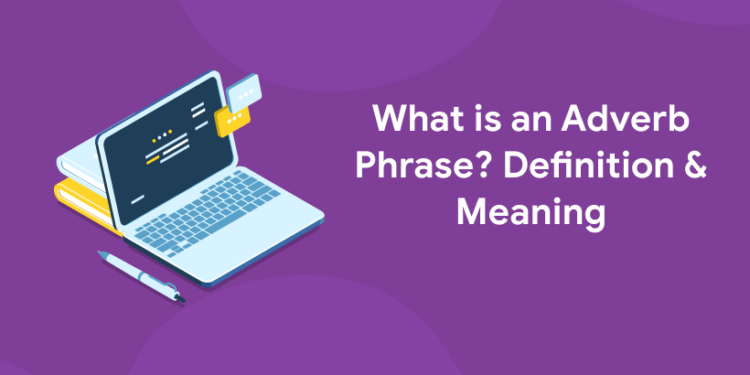Table of Contents
An adverbial phrase is a collection of words that clarify the meaning of a verb, adjective, or adverb. Adverbial phrases, like adverbs, alter other words by clarifying why, how, where, or when something happened. They can also explain the circumstances of an action or object, as well as the extent to which it was impacted.
Enroll for Spoken English Course! Download Entri App!
What is an Adverb?
A word that modifies a verb, an adjective, another adverb, or even an entire sentence is called an adverb. Although many adverbs finish in -ly, some (such as swift) have the same appearance as their adjective equivalents.
Example: He could have run swiftly.
She walked quickly.
Enroll for Spoken English Course! Download Entri App!
Adverbs are frequently used to modify verbs. This implies they explain how an action takes place. Other types of questions concerning how an action was accomplished can be answered with adverbs. They can also tell you when and where something is going to happen. There is one type of verb, however, that does not work well with adverbs. Adjectives, not adverbs, are often required for linking verbs such as feel, smell, sound, seem, and seem.
For example, “I feel badly about what transpired.” Is incorrect
Because “feel” is a verb, an adverb rather than an adjective seems appropriate. “Feel,” on the other hand, isn’t just any verb; it’s a linking verb. An adjective explains what you feel, but an adverb tells how you do the activity of feeling. “I feel badly” denotes a lack of ability to sense emotions. It might make sense to state “I feel badly” if you’re trying to read Braille while wearing thick leather gloves. “I feel bad,” on the other hand, is the phrase to use if you’re wanting to express negative feelings.
Adverbs can also modify other adverbs and adjectives. The adverb’s primary function is to increase the intensity of the adjective.
Example: I will be slightly late for work
Using adverbs to modify another adverb often results in weak and awkward sentence building as in the example given below.
Alice talks rather enormously too loudly
Some adverbs can modify complete sentences, and they are known as sentence adverbs. Among the most common are generally, thankfully, interestingly, and accordingly. Sentence adverbs indicate a general feeling about all of the information in the sentence rather than a specific thing in the sentence.
Example: Fortunately, they had a doctor among the guests attending the gathering.
Adverbs, like adjectives, can convey degrees of comparison, albeit this is a less usual use of them. The comparative and superlative forms of certain “flat adverbs” (adverbs that appear precisely like their adjective counterparts) are the same as the adjective comparative and superlative forms. Rather than relying on comparative and superlative adverbs, it’s frequently best to utilise stronger adverbs (or stronger adjectives and verbs).
Example: She smiled warmly at him
Enroll for Spoken English Course! Download Entri App!
What is a Phrase?
A phrase is a collection of words that together form a ‘conceptual unit,’ as defined by the dictionary (an idea contained in a few words). Clauses are usually made up of phrases. A phrase is not a complete sentence in and of itself. Because they lack a subject and predicate, phrases do not make sense on their own. The following are examples of grammatical phrases:
- Adverb phrase
- Noun phrase
- Prepositional phrase
- Adjective phrase
- Verb phrase
Learn About Aparna Mulberry’s Spoken English Class!
What is an Adverb Phrase?
What is the Definition and Meaning of an adverb phrase? Adverbial phrases are groups of words that serve as adverbs. Adverbial phrases are distinguished from adverbial clauses and single-word adverbs. An adverbial phrase, unlike an adverbial clause, lacks a subject and a verb. Adverb phrases are used to answer questions about how, when, where, or how something was done, as shown in the examples below.
- I kept the vase.
- I kept the vase here.
- I kept the vase right here.
- I kept the vase right here on top of the table.
There is no adverb or adverb phrase in the first sentence. The adverb “here” describes where the vase was kept in the second sentence. The third sentence contains the adverb phrase “right here,” which emphasises the location of the vase and uses a phrase rather than a single adverb. The final sentence contains a longer, more descriptive adverb phrase. Remember that “right here on top of the table” is a prepositional phrase that combines the preposition “on top” with the object “table.” In this case, the prepositional phrase functions as an adverb in the sentence. Because it modifies the verb to provide more information about the location, it is an adverbial and prepositional phrase.
Sign up to attend lectures to improve your speaking skills for the IELTS exams
Types of Adverbial Phrases
Adverb phrases, like adverbs, modify other words by describing when, where, why, or how something was done. They can also explain the state of an object or action, as well as the extent to which an action or object was influenced. Consider the adverbial phrase examples below, which describe when, where, how, and why.
Grab the latest notes on the topic of passive voice in English grammar
Adverbial Phrases that Designate When
- Today afternoon
- As fast as possible
- Before midnight
- After the break
- Any time
Adverbial Phrases that Designate Where
- Around the sun
- At home
- Under the table
- Right here
- By the mailbox
Click here to attempt prepositions practise exam
Adverbial Phrases that Designate How
- Doing well
- Enjoyable
- Quite easily
- Quite interesting
- Very well
Adverbial Phrases that Designate Why
- To have a happy marriage
- For committing crime
- To record a statement
- To revise thoroughly
- For pity’s sake
Register to improve English grammar and better your career prospects
Adverb Phrase Examples
Adverb phrases can appear at any time in a sentence. The following adverb phrase examples demonstrate this.
- Meet him at the lake hotel this afternoon.
- Without thinking, he took away his life.
- She completed the job assigned as quickly as possible.
- To avoid troubling the sleeping schoolchildren, he chose to tiptoe to bed.
- Alice needs to ride her new bike much more carefully.
- To have a clear view of the tower, he climbed to the top.
Register for coaching to learn English grammar for the best performance in bank exams
Always include adverbial phrases in your writing to help your readers understand. This also makes the content more interesting and appealing, which encourages more people to read your work. You should be able to recognise and even classify adverbial phrases in a sentence using the examples provided above. Download the Entri app to get more examples and practise questions on the topic of adverbial phrases.










